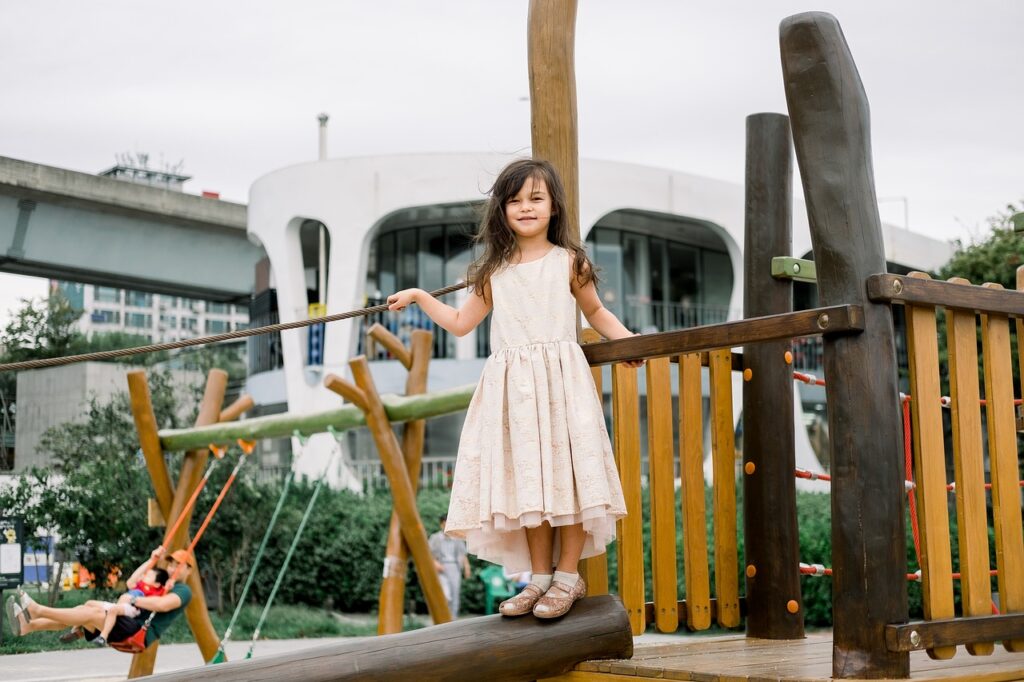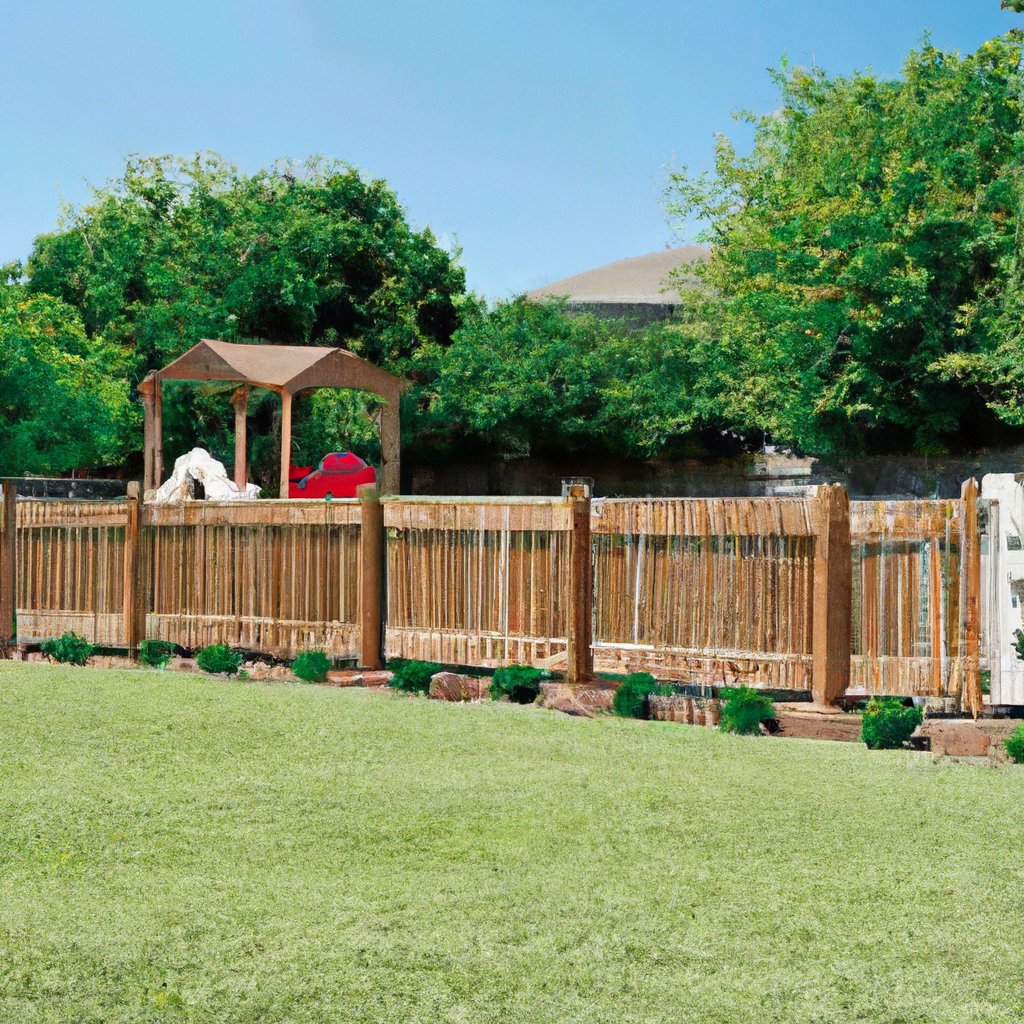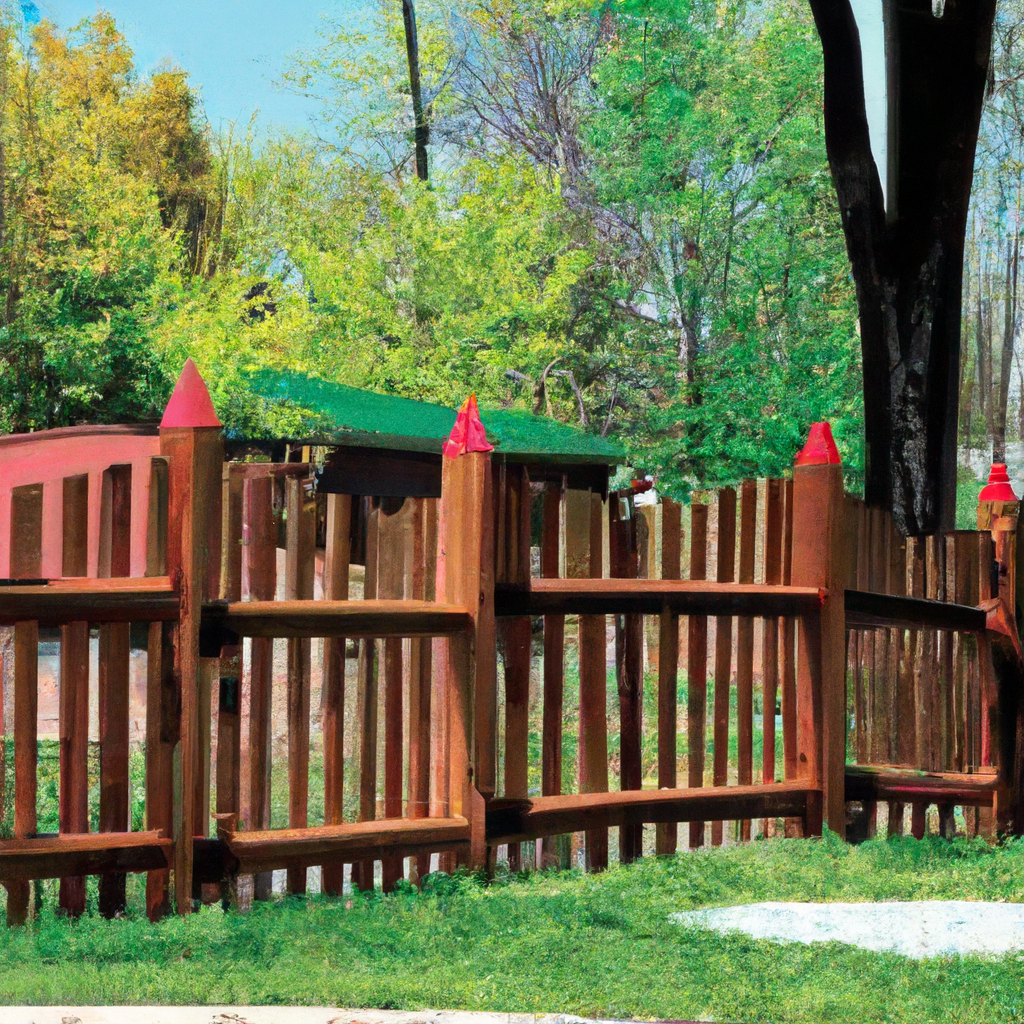Looking to expand his blog about fences, the author aims to provide readers with comprehensive and engaging content that not only educates but also resonates with their interests. Through exploring different fence types, sizes, shapes, and materials, the author seeks to offer valuable knowledge and practical advice for making informed decisions when selecting and installing fences. By discussing factors such as property size, desired level of enclosure, and architectural considerations, the author aims to cover the diversity of fence options and their suitability for various purposes. The goal is to make the blog a go-to resource for all things related to fences.

Designing Fences with Integrated Outdoor Play Areas for Children
When it comes to designing fences for outdoor areas, incorporating play spaces for children can be a fantastic addition. These integrated play areas not only provide a safe and secure environment for children to play but also offer several benefits for their physical, mental, and social development. In this article, we will explore the importance of outdoor play for children, the advantages of designing fences with integrated play areas, factors to consider when designing these fences, suitable fence styles and materials, safety measures to implement, creative ideas for playful fences, maintenance and upkeep tips, landscaping options, and examples of fences with integrated play areas.
Importance of Outdoor Play for Children
Physical Health Benefits
Outdoor play is essential for children’s physical development. It promotes regular exercise, improves coordination, enhances strength and endurance, and reduces the risk of obesity. Children who engage in outdoor activities tend to have better cardiovascular health, stronger bones, and healthier immune systems.
Mental and Emotional Development
Outdoor play also plays a crucial role in the mental and emotional well-being of children. Being in nature and open spaces allows them to explore, engage their senses, and experience a sense of freedom. It helps reduce stress, anxiety, and depression, and promotes emotional resilience.
Social Interaction and Communication Skills
Outdoor play provides ample opportunities for children to interact with their peers, siblings, and other individuals. It helps develop important social skills such as cooperation, negotiation, conflict resolution, and teamwork. Through outdoor play, children learn to express themselves, share resources, and build relationships.
Cognitive and Problem-Solving Skills
Engaging in outdoor play stimulates the brain and enhances cognitive abilities. Children learn to navigate their surroundings, assess risks, problem-solve, and make decisions. Outdoor play encourages curiosity, creativity, and critical thinking, which are essential for their overall cognitive development.
Connection with Nature and the Environment
Spending time outdoors allows children to connect with nature and develop an appreciation for the environment. It fosters a sense of responsibility and encourages sustainable practices. Children who engage in outdoor play from an early age are more likely to grow up with a deep respect for nature and a desire to protect it.
Benefits of Designing Fences with Integrated Play Areas
Enhanced Safety and Security
One of the primary benefits of designing fences with integrated play areas is the enhanced safety and security they provide for children. These fenced-off areas offer parents and caregivers peace of mind, knowing that their children can play freely without the risk of wandering off or being exposed to potential dangers outside the designated area.
Promotion of Physical Activity
Integrating play areas within fences encourages children to engage in regular physical activity. The presence of play equipment such as swings, slides, climbing walls, and balance beams provides opportunities for children to be active and develop their motor skills. This can contribute to their overall health and well-being.
Stimulating Imagination and Creativity
Designing fences with integrated play areas allows for the incorporation of imaginative and interactive elements. These features trigger children’s creativity and encourage imaginative play. Whether it’s a chalkboard fence for drawing or an activity wall for puzzles and games, the design possibilities are endless and can spark hours of imaginative play.
Opportunities for Learning and Skill Development
Fences with integrated play areas offer a unique opportunity for children to learn and develop various skills. From sensory panels that stimulate their senses to educational elements like letter and number games, these play areas can provide a fun and interactive learning environment. Children can develop cognitive, motor, and social skills while engaging in play.
Factors to Consider when Designing Fences with Integrated Play Areas
Age of Children
The age of the children who will be using the play area is an important factor to consider when designing fences with integrated play areas. Play equipment and activities should be age-appropriate, ensuring they cater to the developmental needs and abilities of the children.
Available Space
The available space will dictate the size and layout of the play area and the fence surrounding it. It’s important to consider the dimensions of the area to ensure there is enough room for various play equipment and activities while still allowing for safe movement and supervision.
Budget and Cost Considerations
Budget is another crucial factor to consider when designing fences with integrated play areas. Different materials and features will have varying costs, so it’s essential to establish a budget and prioritize the elements that are most important.
Overall Landscape Design
The design of the fence and integrated play areas should harmonize with the overall landscape design of the outdoor space. Consider the aesthetic elements, such as colors, styles, and themes, to create a visually appealing and cohesive environment.
Accessibility and Inclusivity
Designing a fence with integrated play areas should ensure accessibility and inclusivity for all children. Consider incorporating elements that cater to children with disabilities or mobility challenges, providing ramps or adapted play features to ensure equal opportunities for play and enjoyment.

Suitable Fence Styles for Integrated Play Areas
Picket Fences
Picket fences are a classic choice for integrating play areas. The gaps between pickets allow for visibility and airflow while still providing a safe enclosure. Picket fences can be painted in vibrant colors to create a playful and visually appealing design.
Split Rail Fences
Split rail fences have a charming and rustic look that can beautifully complement a play area. The open design allows children to interact with the surrounding environment while still providing a clear boundary. Add playful elements like hanging baskets or bird feeders to enhance the overall design.
Board-on-Board Fences
Board-on-board fences offer privacy while still allowing for integration of play areas. The design features overlapping boards on the front and back, creating a seamless appearance. Incorporate windows or cutouts in the fence to provide visibility between the enclosed play area and the surroundings.
Lattice Fences
Lattice fences provide a decorative option for integrating play areas. The lattice design allows airflow and visual connection while still maintaining a secure enclosure. Enhance the playfulness by incorporating climbing plants or attaching small accessories like wind chimes or hanging flower pots.
Vertical Slat Fences
Vertical slat fences offer a sleek and modern look for integrated play areas. The evenly spaced slats provide visibility while maintaining security. Customize the fence by painting different color patterns or adding playful designs such as shapes or silhouettes.
Materials for Fences with Integrated Play Areas
Wood
Wood is a popular material choice for fences with integrated play areas due to its versatility and natural aesthetic. Cedar and redwood are common options as they are resistant to decay and rot. Wood can be painted or stained in vibrant colors to create a playful and inviting atmosphere.
Vinyl
Vinyl fences are low-maintenance and provide excellent durability for fences with integrated play areas. They are resistant to fading, cracking, and warping, making them suitable for outdoor environments. Vinyl fences are available in various styles and colors, allowing for flexibility in design.
Metal
Metal fences, such as aluminum or wrought iron, offer strength and durability for play areas. They can withstand heavy use and provide a secure enclosure. Metal fences can be customized with playful accents such as decorative scrolls or finials to add a touch of whimsy.
Bamboo
Bamboo fences provide a natural and eco-friendly option for integrating play areas. Bamboo is a sustainable material that offers strength and durability. Its unique appearance adds a tropical or Asian-inspired aesthetic to the overall design.

Safety Measures for Fences with Integrated Play Areas
Height and Visibility
Ensure that the height of the fence is appropriate to prevent children from climbing or scaling over it. Balusters or pickets should be spaced close enough to prevent a child’s head from getting stuck but still allow visibility for supervision. The fence should be tall enough to discourage unauthorized access.
Narrow Gap Spacing
Ensure that there are no large gaps or spaces between the fence elements where children’s limbs or body parts could get stuck. The spacing between pickets, slats, or lattices should be narrow enough to prevent entrapment or injury.
Secure Gates and Latches
Install secure gates and latches that are childproof and only operable by adults. This will prevent children from accidentally leaving the play area and ensure their safety within the enclosed space. Regularly inspect and maintain gates and latches to ensure they remain in good working condition.
Smooth and Rounded Edges
Ensure that all edges and corners of the play equipment within the fenced area are smooth and rounded to minimize the risk of cuts, scrapes, or other injuries. Regularly inspect the play equipment for any sharp or jagged edges and promptly address any issues.
Childproof Locks and Hardware
If the fence has additional accessories like drawers or compartments, ensure that locks and hardware are childproof and secure. This will prevent children from accessing potentially dangerous items or areas within the fenced play space.
Creative Ideas for Designing Playful Fences
Chalkboard Fences
Incorporate chalkboard paint into the fence design to create a designated area for children to unleash their creativity. Children can draw, write, and erase on the fence, allowing for imaginative play and artistic expression.
Play Panels and Activity Walls
Install play panels or activity walls within the fence to add interactive elements. These panels can feature mazes, gears, mirrors, and other tactile and visual activities to engage children’s senses and promote cognitive development.
Built-in Slides and Swings
Consider integrating built-in slides or swings within the fence structure to provide additional play opportunities. These features can be securely attached to the fence and offer endless fun for children.
Interactive Elements and Sensory Zones
Include interactive elements such as water play, sandboxes, musical or sensory walls, or nature-inspired features like butterfly houses or planters. These additions can create a multi-sensory experience for children and encourage exploration and discovery.
Artistic Murals and Paintings
Transform the fence into a work of art by incorporating murals or paintings. These colorful and imaginative designs can enhance the visual appeal of the play area and inspire children’s creativity.

Maintenance and Upkeep of Fences with Integrated Play Areas
Regular Cleaning and Inspection
Regularly clean the fence to remove dirt, debris, and any potential hazards. Inspect the fence, play equipment, and surrounding area for any signs of wear, damage, or deterioration. Promptly address any maintenance or repair needs to ensure the continued safety and functionality of the play area.
Repairs and Replacement
If any part of the fence or play equipment becomes damaged or broken, it is important to repair or replace it promptly. Broken or loose boards, splinters, or faulty hardware pose safety risks to children and should be addressed immediately.
Weather Protection and Sealants
Apply weather-resistant sealants or coatings to protect wooden fences from the elements. This helps prevent rotting, warping, or fading and extends the lifespan of the fence. Regularly inspect sealants and reapply as necessary.
Consistent Monitoring of Safety Features
Regularly monitor the safety features of the fence, such as gates, latches, and other childproof elements. Ensure they remain in good working condition and meet the necessary safety standards. Adjust or replace any features that are no longer functioning properly.
Landscaping Options for Fences with Integrated Play Areas
Grass and Turf
Incorporate grass or artificial turf around the play area to create a soft and comfortable surface for children to play. Grass provides a natural and eco-friendly option, while artificial turf offers low maintenance and durability.
Mulch and Rubber Surfacing
Choose mulch or rubber surfacing as a safety measure around play equipment and high-impact areas. These materials provide cushioning in case of falls and minimize the risk of injuries.
Plantings and Greenery
Integrate plantings and greenery around the fence to create a visually appealing and nature-filled environment. Consider planting shrubs or flowers along the perimeter of the play area to enhance the overall landscape.
Natural Rock Features
Use natural rocks or boulders strategically to add interest and promote natural play elements. Rocks can be incorporated into the design as stepping stones, climbing features, or even as a backdrop for cascading water features.

Examples of Fences with Integrated Play Areas
Residential Backyard Playground Fence
A residential backyard playground fence can include elements such as swings, slides, climbing walls, and playhouses. Combining a sturdy fence with these fun play features creates a safe and exciting play environment for children.
School Playground Fence
School playground fences can be designed to accommodate a variety of play equipment and activities. From traditional playground structures to sports courts, a well-designed fence ensures safety and security for students while providing ample space for recreation.
Public Park Fence
Fences in public parks can integrate play areas suitable for children of all ages. These fences may include activity walls, sensory paths, and nature-inspired elements to encourage learning, exploration, and physical activity.
Community Center Fence
Community centers can design fences with integrated play areas to cater to the needs of their diverse population. These play areas can include equipment suitable for different age groups and may even incorporate inclusive features to ensure accessibility for all.
Common Questions about Fences
- What are the best fence materials for a play area?
- The best fence materials for a play area depend on various factors such as durability, safety, and maintenance. Some common options are wood, vinyl, metal, and bamboo.
- How should I choose the height of the fence for a play area?
- The height of the fence should be determined based on the age of the children and the desired level of security. It should be tall enough to prevent easy climbing but also allow for visibility and supervision.
- Are there any safety regulations to consider when designing fences with integrated play areas?
- Yes, there may be safety regulations and guidelines depending on your local jurisdiction. It’s important to research and comply with any applicable safety regulations to ensure the play area meets all necessary standards.
- What types of play equipment can be integrated into the fence design?
- The play equipment that can be integrated into the fence design is vast. It can range from slides and swings to interactive panels, sensory zones, and even artistic elements such as murals or paintings.
- How often should fences with integrated play areas be inspected for maintenance?
- Fences with integrated play areas should be inspected regularly for maintenance. A general guideline is to inspect the play equipment and fence at least once a month for any signs of wear, damage, or potential hazards.
- What are some landscaping options to consider around fences with integrated play areas?
- Landscaping options around fences with integrated play areas can include grass, turf, mulch, rubber surfacing, plantings, and natural rock features. These options can enhance the overall design and safety of the play area.
- How can I ensure the fence design is inclusive for children with disabilities?
- Ensuring inclusivity for children with disabilities can be done by incorporating features such as ramps, adaptive play equipment, and ensuring accessibility within the play area. Consulting with experts or organizations specializing in inclusive play can provide valuable guidance.
- Are there any specific safety measures to consider for gates and latches?
- Gates and latches should be childproof and only operable by adults. They should be regularly inspected for smooth operation and secure closure. Childproof locks or mechanisms should be used to prevent unauthorized access.
- What is the recommended spacing between pickets or slats to prevent entrapment?
- The recommended spacing between pickets or slats should be less than 3.5 inches to prevent entrapment of a child’s head or body. Ensure that there are no large gaps or spaces where a child’s limb could get stuck.
- Is it necessary to obtain permits for building fences with integrated play areas?
- Permit requirements for building fences with integrated play areas vary depending on your location and local building codes. It is important to research and comply with any necessary permits or requirements before construction begins.
